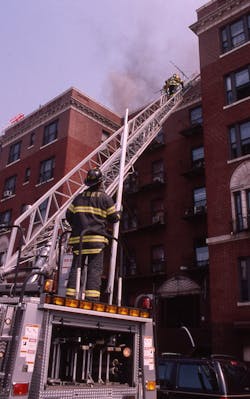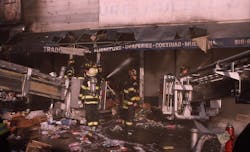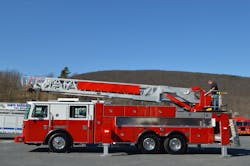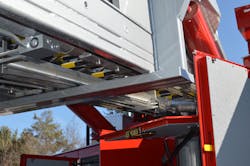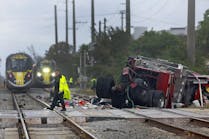Choosing the Right Type of Aerial for Your District's Needs
There are any number of questions that must be addressed by a department’s apparatus committee when beginning the process of developing requirements for a new aerial device. This can be daunting, particularly if the aerial or tower apparatus that will be acquired for use in the response district is the first to be purchased.
The initial purchase price, along with the annual operating and maintenance costs, will make this the most expensive vehicle in your fleet over its anticipated life cycle. In addition, the principal apparatus dimensions, including wheelbase, overall length and overall height, along with the aerial device vertical- and horizontal-reach capabilities, have a dramatic effect on the vehicle’s operational effectiveness on the fireground.
We all probably heard a story of a department that acquired a new aerial platform that was the largest one that would fit into the apparatus bays, only to find that it was too large to safely traverse the roadways in the first-due area or that it was too heavy for some bridges, which rendered the vehicle useless in a portion of the community. If your department is replacing an existing aerial apparatus, you have an advantage, because you have the situational awareness to recognize the unit’s limitations to access the different types of buildings that have setbacks, green spaces, parking and fire lane access.
A knowledgeable fireground commander once observed, “They did not provide a paved roadway around every building that might have a structural fire.” With this basic principle in mind, depending on the location of a building and the access points for your aerial apparatus, you might need to position your truck company on the rear, or C side, of the fire building. Proper apparatus positioning for the first- and second-due truck companies largely is dependent on the size and the type of aerial device and the points of building access that are available for safe and effective placement.
Scrub area
Three significant apparatus dimensions on any aerial device influence the effective scrub area: vertical reach, horizontal reach and outrigger stance. Scrub area is the vertical surface area of a structure that can be reached or touched with the tip of an aerial ladder or platform on a tower apparatus.
In some communities where mid- and high-rise buildings are prevalent, the vertical reach of the device is most important. In many response districts that have three- and four-story multifamily structures that have any number of setbacks, the rated horizontal reach is much more important, because the elevation angle typically will be less than 50 degrees, where vertical reach is based on the maximum elevation angle of the device.
A vehicle’s outrigger stance is measured from the centerline of the outrigger pad on each side of the vehicle. This dimension typically ranges from 12–16 feet on aerial ladders and from 16–20 feet on different models of aerial towers and tower ladders. Outrigger stance and type of stabilizer beams have a dramatic effect on apparatus positioning, whether the latter be the A-frame, out-and-down or vertical type of stabilizer.
Each of these design characteristics, along with apparatus positioning relative to the building and aerial device limitations and collision-avoidance systems, influences the effective scrub area. Scrub area is a key consideration when evaluating different types of aerial devices and is just as important as being able to reach the roof of a burning building or to flow water during defensive operations.
At any incident, you want to be able to raise, lower and rotate the aerial device in any direction without limitations. However, with many apparatus designs, different parts of the vehicle can get in the way, particularly when you are operating at low angles of elevation.
When developing specifications for new aerial devices, be mindful of the cab configuration. Raised roof cabs can limit scrub area toward the front of a vehicle severely, particularly for a mid-mount tower. When operating over the front of the vehicle, a raised roof cab can limit low-angle operations.
Apparatus manufacturers typically offer several body compartment designs in different heights. High side compartments can have a detrimental effect on scrub area when operating the aerial device at a low angle off of the side of the vehicle. This applies particularly at storefront and taxpayer fires where the platform bucket must be close to the ground for master stream operations. During the design phase, the apparatus committee’s decision to mount cord reels, scene lighting or saw boxes on top of compartments could create the same type of obstruction as a full-height compartment.
Collision avoidance
As more aerial devices utilized multiplex electronics, collision-avoidance systems were developed to prevent apparatus operators from accidently lowering or rotating the aerial device into the cab, compartments or other mounted equipment that’s on top of compartments. An impact between a moving aerial device and a part of the vehicle can do significant damage.
New systems are programmed using a drawing that indicates all of the obstructions that must be avoided and their position in relation to the turntable. The systems then are set to stop the aerial device a certain distance away from these danger areas to prevent a collision. This is a complicated process, because the computer must recognize that the aerial device is moving toward a potential impact and slow the device’s movement in time to stop gently before the impact occurs.
Today, no industry standard defines exactly how the systems are programmed. Some collision-avoidance systems are set up rather well and stop the aerial device about six inches from the potential impact point. In other cases, systems prevent the aerial from coming within two feet of the obstruction. The excessive distance can restrict boom or ladder movements needlessly and reduce the scrub area dramatically. During final inspections, the committee should confirm the collision-avoidance system parameters to ensure that clearances between the aerial device, the cab and the body are adjusted correctly and don’t restrict operations unnecessarily.
One of the most important considerations in positioning an aerial apparatus is the distance between the vehicle and the building. The capability to operate in tight spaces is directly related to the length of the ladder or boom when it’s fully retracted. These low-angle capabilities vary considerably based on the configuration of the vehicle (mid-mount or rear-mount) and the amount of space that’s available to position the vehicle adjacent to the building.
Aerial apparatus operational footprint refers to the space that’s required to set up and operate aerial apparatus at the scene of a fire, based on the full outrigger stance, to permit unrestricted operations at any position. The footprint can be reduced in the short-jacked mode, where the outriggers are extended fully on the side that faces the building where the aerial device will be operated. The jacks that are on the outboard side aren’t extended or only partially extended before being lowered. The jack spread is essential to maintain the stability of the vehicle and to prevent it from overturning. If the aerial device only will be operated to one side of the vehicle, the extension of the outboard jacks doesn’t contribute to the stability of the vehicle. Most modern aerial devices have limit switches that prevent rotating to the side that’s short-jacked, although accidents occurred when the operator attempted to perform a function that overrode the built-in safety devices.
Tractor-Drawn, Rear-Mount & Mid-Mount
Going back in apparatus history, tractor-drawn aerial ladders were utilized by many departments, because they were capable of carrying an extensive array of ground ladders in addition to truck company equipment. Today, the tractor-drawn aerial ladder continues to provide the best maneuverability, the greatest amount of compartment space and the capability to carry in excess of 300 feet of ground ladders.
Rear-mount aerial ladders offer similar aerial vertical- and horizontal-reach capabilities to tractor-drawns but on a shorter apparatus. When properly designed, rear-mount aerials can be outfitted with a good assortment of tools, equipment and ground ladders.
In the world of aerial towers and tower ladders, the mid-mount tower has some distinct operational advantages on the fireground. That said, careful research to develop a well-designed tower is required, whether it be an aerial tower or a tower ladder.

Tom Shand
TOM SHAND, who is a Firehouse contributing editor, is a 36-year veteran of the fire service. He works with Michael Wilbur at Emergency Vehicle Response, consulting on a variety of fire apparatus and fire department master-planning issues. Shand is a member of the Firehouse Hall of Fame.
